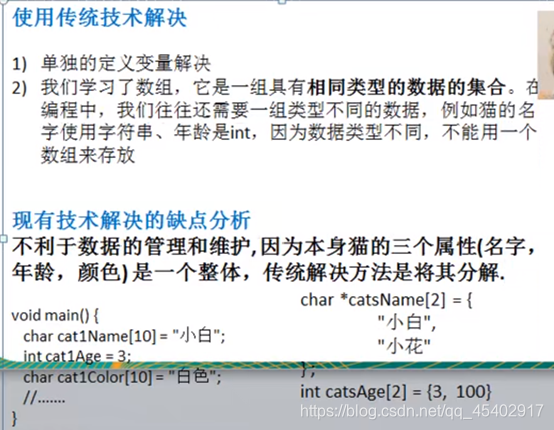引入

使用传统技术解决
需要定义多个变量或数组

结构体与结构体变量的关系示意图
类似Java类中的对象(结构体)与属性(结构体变量)
一切物体都可以看作对象(结构体)

补充:C语言数据类型

简单使用案例

代码
Cat是我们自己定义的数据类型
struct Cat cat1;//创建struct Cat的一个变量


练习
输入字符串,匹配person信息
#include<stdio.h>
#include<string.h>
//结构体 struct
//输入字符串,匹配person信息
#define SIZE 100
int main()
{char s[SIZE];printf("please input s:\n");gets(s);struct Person{char *name;int age;char *car;};//不要忘记;struct Person p1;struct Person p2;p1.name="dq";p1.age=18;p1.car="WT";p2.name="ww";p2.age=12;p2.car="ET";if(strcmp(s,p1.name)==0){printf("name=%s age=%d car=%s\n",p1.name,p1.age,p1.car);}else if(strcmp(s,p2.name)==0){printf("name=%s age=%d car=%s\n",p2.name,p2.age,p2.car);}else{printf("no found\n");}getchar();//entergetchar();return 0;
}
结构体和结构体变量的区别和联系

结构体变量在内存中的布局

结构体成员
声明结构体/结构体包含的变量

结构体成员的基本介绍

注意事项

结构体定义的三种形式
创建结构体的三种方式
方式1:

方式2:

方式3:匿名结构体

结构体成员的获取和赋值
方式1:

方式2:

使用案例:

整体使用代码
#include<stdio.h>
//定义结构体的方式&结构体成员的定义和赋值方式int main()
{//定义结构体的方式1struct A{int aage;char*aname;};struct A a={99,"A"};printf("age=%d name=%s\n",a.aage,a.aname);//定义结构体的方式2struct B{int bage;char*bname;}b;//没有b={90,"B"}; 因为struct B是一个整体,只有struct B b={90,"B"}b.bage=10;b.bname="B";printf("age=%d name=%s\n",b.bage,b.bname);//定义结构体的方式3struct{int cage;char*cname;}c={88,"C"};printf("age=%d name=%s\n",c.cage,c.cname);getchar();return 0;
}
结构体案例练习1

补充:spintf()函数
Sprint(字符串,”%原先的类型”,要转换的数据类型变量)
将其他数据类型转换到字符串中
“%8.2f”代表一共有8位,2代表小数的位置,不够用空格补齐
结构体是值传递,在传递时会拷贝一份值,对原来的值没有影响
#include<stdio.h>
//小狗案例
char*say(struct Dog dog);
struct Dog{//结构体char *name;int age;double weight;
}dog={"dog",3,10.8};
int main()
{char*s=say(dog);printf("结果:%s\n",s);getchar();return 0;
}
char*say(struct Dog dog)//形参为struct Dog类型{static char info[100];//局部变量/*Sprint(字符串,”%原先的类型”,要转换的数据类型变量)将其他数据类型转换到字符串中*/sprintf(info,"name=%s age=%d weight=%.2f",dog.name,dog.age,dog.weight);dog.name="MMMM";//对输出的内容没有影响//结构体是值传递,在传递时会拷贝一份值,对原来的值没有影响return info;
}
结构体案例练习2

代码
#include<stdio.h>
//结构体--盒子案例
char* info(struct Box box);
struct Box{double l;//长double w;//宽double h;//高
};
int main()
{double l;//长double w;//宽double h;//高printf("please input the information of box:\n");//double %lfscanf("%lf %lf %lf",&l,&w,&h);struct Box box={l,w,h};printf("information:%s\n",info(box));getchar();//entergetchar();return 0;}
char* info(struct Box box)
{static char s[100];//局部变量--staticdouble v=box.l*box.w*box.h;sprintf(s,"l=%.2f w=%.2f h=%.2f v=%.2f",box.l,box.w,box.h,v);return s;
}
结构体案例练习3

代码:
strcmp()==0与!strcmp()效果一样
!strcmp()//0代表假,非0为真,所以使用!取反(真取反为0)
visitor.name是数组,本身就是地址,而visitor.age是整型变量,要使用&visitor.age取地址(优先级:.高于&)
*visitor:获取的是visitor本身
#include<stdio.h>
#include<string.h>
//结构体--景区门票案例:使用地址传递//函数原型/声明
double ticket(struct Visitor*visitor);
struct Visitor{char name[10];int age;double pay;//需要支付的门票
} visitor;
int main()
{int i=1;while(1){printf("please input information%d:name age\n",i);scanf("%s %d",visitor.name,&visitor.age);if(!(strcmp(visitor.name,"n"))){break;//结束while循环}visitor.pay=ticket(&visitor);printf("pay=%.2f\n",visitor.pay);i++;}printf("exit\n");getchar();//entergetchar();return 0;
}
//使用结构体指针,传递地址,提高效率
double ticket(struct Visitor*visitor)
{//使用*visitor取的具体的visitor变量if((*visitor).age>=18)return 20;elsereturn 0;
}
函数)





)








装有系统,将其中系统安装到另外一块磁盘的具体操作)



)